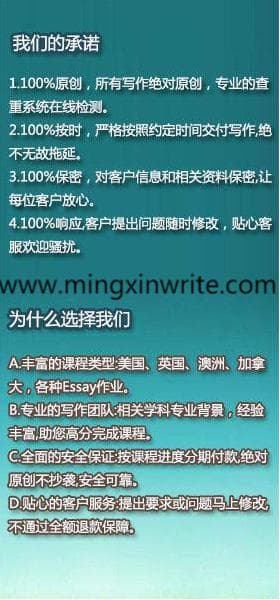发布时间:2020-12-16 热度:
生物学essay代写,高分essay代写指导,生物学网课代修,生物学作业代写
Question #1:
(1)Briefly describe how information flows through neurons.
The information flows from one neuron to another neuron by chemical synapse, which is composed by a presynaptic membrane, synaptic cleft, and postsynaptic membrane. Each part of the chemical synapse plays a significant role in the process of information flow. The specific procedures are that: the presynaptic membrane releases a neurotransmitter substance into the synaptic cleft. Through the synaptic cleft, the neurotransmitter substance transforms from the presynaptic membrane to the postsynaptic membrane and binds itself with the receptor on the postsynaptic membrane, which makes the acetylcholine to activate.
(2A) Fill in the blanks below based on what was discussed in class.
Alzheimer’s Disease leads to nerve cell death and tissue loss throughout the brain. The __brain__ shrivels up, damaging areas involved in thinking, planning and remembering. Shrinkage is especially severe in the __hippocampus__, an area of the cortex that plays a key role in formation of new memories.
(2B) Briefly describe the two genes that are implicated in early-onset Alzheimer’s Disease and how they are thought to contribute to the disease, and the gene most associated with late-onset Alzheimer’s Disease.
Presenilin 1 gene and presenilin 2 gene are the two genes that are implicated in early-onset Alzheimer’s Disease. Presenilin 1 gene can cause the familial Alzheimer's type 3 disease through the mutation of this gene while presenilin 2 gene can cause the familial Alzheimer’s type 4 disease. As to the late-onset Alzheimer’s Disease, the APOE gene is the gene that is associated with the disease the most due to the APOE gene’s E4 variant.

Question #2:
(1)Mr. Trojan just turned 70 and finds that it is increasingly difficult to breath. The doctor tells him that he has congestive obstructive pulmonary disease (COPD). Explain to Mr. Trojan what COPD is, including the two major lung diseases discussed in class, and how that may affect his daily activities.
The term COPD is to describe a series of progressive lung diseases such as emphysema, chronic bronchitis, and refractory (non-reversible) asthma. In other words, the COPD is the compilation of certain type of lung diseases. Emphysema is a disease that involves conditions like the damage to the lung tissue, the destruction of the alveoli. Chronic bronchitis is the inflammation of the bronchial tubes, which can cause people to breathe shortly, possible fever, wheeze, and so on. As a type of asthma, the refractory asthma is more severe than normal asthma since it can cause the airway of the patients to swell and become narrow, which will make the breath harder for the patients.
(2)Briefly describe (A) why smoking is harmful and (B) list five of the many major diseases that are linked to smoking.
Smoking is harmful to people because the smoke of the cigarettes contains numerous elements that can cause severe diseases to people. For instance, the burning herbs of the cigarettes produce carbon monoxide through the incomplete combustion, which can cause damage to the lungs. What is more, the habit of smoking can cause numerous diseases like lung cancer, heart attacks, vascular stenosis, and so on. Moreover, smoking is also the trigger factor of diseases like Alzheimer's disease, periodontitis, and so on. Overall, smoking indeed cause damages to the human body.
Question #4:
(1)You just ate a sandwich during a wonderful seminar and your body is working hard to extract the nutrients. Describe the journey your food will take through your key digestive systems, starting from ingestion to excretion.
a.The process of digesting the food starts when people chewing it in their mouth, which is the first digestive system of human beings. When people chewing the food in their mouth, the saliva, which contains the enzymes that will break down the food in your mouth to the level that the human body can absorb.
b.Through the enzymes, the food will reach the second digestive system, the stomach. In the stomach, the produced acid and enzymes will continue to break down the food into the form of the paste.
c.Then the food will reach the small Intestine and start its full absorption. Through the enzymes of the duodenum, jejunum, and ileum, the wasted materials of the food are being transformed into the final digestive system of human beings, the colon.
d.In the colon, the left water in the food will still be absorbed. When the colon is filled with the wasted material, those stools will go to the rectum. Then the brain of human beings will decide that whether the stools will go out through the anus or not.
(2)Describe one aspect of the digestive system that can decline with age and how that will affect the health of an elderly person.
When the decline of the human body happens through the development of the human age, the digestive system of people will also suffer some decline. For instance, the esophageal contractions will weaken with the increasing age.
Question #5:
(1)List the utility and limitations of body mass index (BMI).
a.Utilities of BMI:
i.It provides a specific standard for people to measure the fatness of themselves;
ii.It can also be used in the perception of certain diseases caused by the over-weight, such as the heart attack, high blood pressure, and so on.
b.Limitations of BMI:
i.Sex and age perspective: from the biological structure, the female people and older people naturally have more body fat among the human species.
ii.The athletes or other people with a high level of muscularity will not fit into the BMI.
iii.The BMI also does not reflect the distribution of the fat, which will make the result of the BMI less effective when judging the health risks of people.
(2)Research shows that many of the chronic diseases seen in adults in the US today are directly influenced by consumption of the "Western Diet" and poor lifestyle choices. Describe at least two specific components of the "Western Diet" and at least two negative lifestyle choices that are contributing to chronic illness. For example, low fiber in foods, excessive alcohol consumption.
a.Low Fiber in Foods: Many people in the United States of America will choose to keep a low fiber diet in order to keep slim. However, the low fiber in foods can make people get severe diseases like Chronic Constipation, diabetes, colon cancer, and so on. Therefore, in order to keep a healthy body, people should stop the low fiber diet.
b.Excessive Alcohol Consumption: The drinking issues indeed exist in the society of the United States of America. Besides the negative influences it brings to the human lifestyle, It can also trigger certain chronic diseases such as heart diseases, stroke, cancers of the mouth, throat, and breast, and so on.








